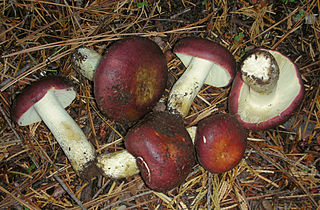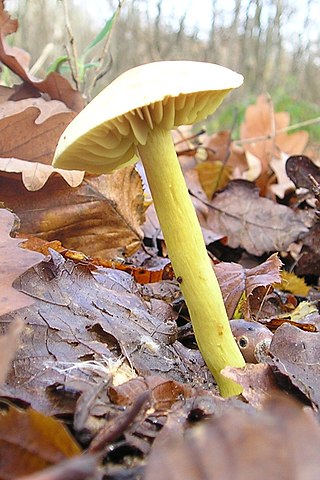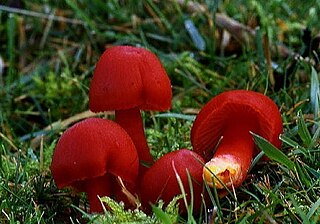
Russula xerampelina, also commonly known as the shrimp russula, crab brittlegill, or shrimp mushroom, is a basidiomycete mushroom of the brittlegill genus Russula. Two subspecies are recognised. The fruiting bodies appear in coniferous woodlands in autumn in northern Europe and North America. Their caps are coloured various shades of wine-red, purple to green. Mild tasting and edible, it is one of the most highly regarded brittlegills for the table. It is also notable for smelling of shellfish or crab when fresh.

Tricholoma is a genus of fungus that contains many fairly fleshy white-spored gilled mushrooms which are found worldwide generally growing in woodlands. These are ectomycorrhizal fungi, existing in a symbiotic relationship with various species of coniferous or broad-leaved trees. The generic name derives from Ancient Greek: τριχο-, romanized: tricho-, lit. 'hair' and Ancient Greek: λῶμα, romanized: loma, lit. 'fringe, border' although only a few species have shaggy caps which fit this description.

Russula cyanoxantha, synonymous with R. xyanoxantha, commonly known as the charcoal burner or variegated russula, is a basidiomycete mushroom, distinguished from most other members of the genus Russula by the fact that its gills do not split, but are soft and flexible. It is one of the most common species of Russula in Europe.

Tricholoma sulphureum, also known as the stinker, sulphur knight or gas agaric, is an inedible or mildly poisonous mushroom found in woodlands in Europe. It has a distinctive bright yellow colour and an unusual smell likened to coal gas. It occurs in deciduous woodlands in Europe from spring to autumn.

Clitocybe nebularis or Lepista nebularis, commonly known as the clouded agaric, cloudy clitocybe, or cloud funnel, is an abundant gilled fungus which appears both in conifer-dominated forests and broad-leaved woodland in Europe and North America. Appearing in Britain from mid to late autumn, it is edible, but may cause gastrointestinal issues.

Panaeolus semiovatus var. semiovatus, also known as Panaeolus semiovatus and Anellaria separata, and commonly known as the shiny mottlegill, ringed panaeolus, or egghead mottlegill, is a medium-sized buff-colored mushroom that grows on horse dung, and has black spores. Though nonpoisonous, it is generally regarded as inedible, and a few people experience gastric upset after consumption.

Sarcodon imbricatus, commonly known as the shingled hedgehog or scaly hedgehog, is a species of tooth fungus in the order Thelephorales. The mushroom is edible. Many sources report it has a bitter taste, but others have found it delicious and suspect that the bitter specimens may be similar related species. The mushroom has a large, brownish cap with large brown scales and may reach 30 cm (12 in) in diameter. On the underside it sports greyish, brittle teeth instead of gills, and has white flesh. Its spore print is brown. It is associated with spruce (Picea), appearing in autumn. It ranges throughout North America and Europe, although collections from the British Isles are now assigned to the similar species Sarcodon squamosus.

Russula claroflava, commonly known as the yellow russula, yellow swamp russula or yellow swamp brittlegill, is a basidiomycete mushroom of the genus Russula. It is found in wet places under birch and aspen woodlands across Europe and North America. It has a yellow cap, white gills and stipe and bruises grey. It is mild-tasting and regarded as good to eat.

Hygrocybe coccinea, sometimes called the scarlet hood, scarlet waxcap or righteous red waxy cap, is a colourful member of the mushroom genusHygrocybe. These waxcaps are found across the Northern Hemisphere from China and Japan to Europe and North America. The small bright red mushroom is a familiar sight in unimproved grasslands in Europe in late summer and autumn, and woodlands in North America in winter.

Russula nigricans, commonly known as the blackening brittlegill or blackening russula, is a gilled mushroom found in woodland in Europe. It gains both its common and scientific name from its propensity to turn black from cutting or bruising.

Russula sanguinaria, commonly known as the bloody brittlegill or rosey russula, is a strikingly coloured mushroom of the genus Russula, which has the common name of brittlegills. It is bright blood-red, inedible, and grows in association with coniferous trees. It was previously widely known as Russula sanguinea.

Hortiboletus rubellus, commonly known as the ruby bolete, is a small, dainty, brightly coloured member of the family Boletaceae, with a reddish cap and stipe, and yellow pores. Like many boletes, it stains blue when cut or bruised. It is found in deciduous woodland in autumn. There is some question over its edibility, and it is reportedly of poor quality with a taste of soap. Until 2015, the species was known as Boletus rubellus.

Russula brevipes is a species of mushroom commonly known as the short-stemmed russula or the stubby brittlegill. It is widespread in North America, and was reported from Pakistan in 2006. The fungus grows in a mycorrhizal association with trees from several genera, including fir, spruce, Douglas-fir, and hemlock. Fruit bodies are white and large, with convex to funnel-shaped caps measuring 7–30 cm (3–12 in) wide set atop a thick stipe up to 8 cm (3 in) long. The gills on the cap underside are closely spaced and sometimes have a faint bluish tint. Spores are roughly spherical, and have a network-like surface dotted with warts.

Russula delica is a mushroom that goes by the common name of milk-white brittlegill, and is a member of the genus Russula, all of which are collectively known as brittlegills. It is mostly white, with ochraceous or brownish cap markings, and a short robust stem. It is edible, but poor in taste, and grows in coniferous, broadleaved, or mixed woods. It can be confused with other white Russula species and certain white Lactarius species.

Tricholoma ustaloides is a species of mushroom in the large genus Tricholoma. It has a widespread distribution in Europe, where it is typically found in association with oak and beech trees. Although generally considered inedible, it is consumed by some in Mexico.

Cortinarius mucosus, commonly known as the orange webcap or the slimy cortinarius, is a species of mushroom in the family Cortinariaceae. In North America, the species is more commonly associated with northern coniferous forests. The specific epithet is derived from the Latin word mucosus, meaning mucus.

Lepiota castanea, commonly known as the chestnut dapperling or petite parasol, is a deadly poisonous, uncommon, gilled mushroom of the genus Lepiota in the order Agaricales. It is known to contain amatoxins and consuming this fungus can be a potentially lethal proposition. It was described by French mycologist Lucien Quélet in 1881.

Russula albidula is a species of mushroom in the genus Russula. The species, known in the vernacular as the boring white russula or the whitish brittlegill, is nondescript, with a small or medium dirty white fruit body, and a highly acrid taste. It is found in eastern North America.

Floccularia albolanaripes is a species of fungus in the family Agaricaceae. Mushrooms are characterized by their yellow caps with a brownish center and scales over the margin, and the conspicuous remains of a partial veil that is left on the stipe. The species grows in the Pacific Northwest and the Rocky Mountains of North America, and in India.

Hygrocybe flavescens, commonly known as the golden waxy cap, is a species of Hygrocybe described from Michigan. It is considered nonpoisonous to humans. The species can be found in various forests and woodlands.




















